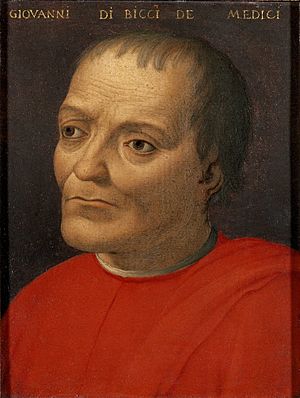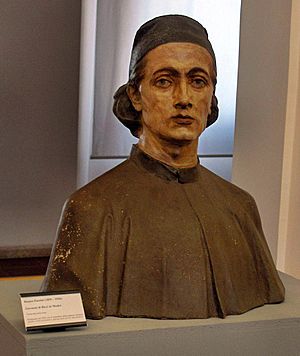Giovanni di Bicci de' Medici facts for kids
Quick facts for kids
Giovanni de' Medici
|
|
|---|---|

Portrait by Agnolo Bronzino
|
|
| Born | 1360 Florence, Republic of Florence |
| Died | 20 February 1429 (aged 69) Florence, Republic of Florence |
| Noble family | Medici |
| Spouse(s) | Piccarda Bueri |
| Issue | Cosimo de' Medici Damiano Lorenzo the Elder Antonio |
| Father | Averardo de' Medici |
| Mother | Jacopa Spini |
Giovanni di Bicci de' Medici (born around 1360 – died February 1429) was an important Italian banker. He was the person who started the famous Medici Bank. This bank helped the Medici family become very powerful in Florence, Italy.
Giovanni was the father of Cosimo de' Medici and Lorenzo the Elder. His family later included famous people like Lorenzo de' Medici (known as "the Magnificent").
Contents
Giovanni's Life Story
Giovanni di Bicci de' Medici was born in Florence, Italy. His father, Averardo, passed away in 1363. Giovanni received only a small part of his father's money.
Luckily, his uncle, Vieri de' Medici, was a well-known banker. Vieri helped Giovanni start his career in banking. Giovanni worked hard and became a junior partner in the bank's branch in Rome.
Starting the Medici Bank
In 1393, Vieri de' Medici retired. Giovanni then took over the bank. Under Giovanni, the Medici Bank grew very quickly. It became so successful that it handled the money for the Church. This made the Medici Bank the "Chief Papal Banker."
The Medici family bank, which Giovanni started in 1397, was his main business. It had branches in many cities in northern Italy and other countries. It was like an early "multi-national" company.
Supporting Art and Architecture
Giovanni also owned two workshops that made wool. He was part of two important guilds (groups of skilled workers).
In 1402, he was one of the judges who chose Lorenzo Ghiberti's design. This design was for the beautiful bronze doors of the Florence Baptistery.
Giovanni also paid for the building of the sacristy (a room for sacred items) in the Church of San Lorenzo. This was in 1418. He chose Filippo Brunelleschi as the architect. He also picked Donatello to create the sculptures. These were some of Giovanni's many gifts to the art world.
Helping the Papacy
In 1414, Giovanni believed the papacy (the Pope's office) would return to Rome. It had been away for a long time. He was right! The papacy moved back to Rome in 1417.
Pope Martin V was thankful for Giovanni's support. He gave Giovanni's bank manager control of the Church's money. Later popes also used the Medici banks. Giovanni also got contracts to collect taxes and rights to many alum mines from the Church.
He helped his family become one of the richest in Europe. This was a big step towards their future fame and power. He also married Piccarda Bueri. Her old and respected family brought him a large dowry (money or property given by the bride's family).
In 1418, Giovanni worked with Niccolò da Uzzano, a noble from Florence. They helped free Antipope John XXIII, who was in prison. Giovanni paid a large amount of money, 38,000 ducats, himself. When the former pope died in Florence, Giovanni paid for his grand tomb in the Baptistery.
A Humble Leader
Even with his growing wealth, Giovanni tried to stay close to the people of Florence. He made sure he and his sons dressed and acted like regular citizens. He did not want to draw too much attention to his family. He wanted the Medici family to be liked by everyone.
He hoped to build a good reputation for his family. He avoided problems with the law and kept the people of Florence happy. He once wrote to his son Cosimo, "Try to keep the people at peace... Do not get involved in legal problems... Do not draw public attention to yourselves."
Giovanni's Role in Politics
Giovanni usually stayed away from politics. But he was asked to take on important roles in the government of Florence. This was because he was well-liked by everyone.
He served as a Priore (a high official) in 1402, 1408, and 1411. In 1421, he was a Gonfaloniere for two months. This was a very important position. In 1407, he was also the governor of Pistoia.
Giovanni always supported the common people. He was against the rich nobles of Florence. In 1426, he used his influence to change a unfair tax. He replaced the old tax with the Catasto. This was a property tax that made it harder for rich nobles to avoid paying their share.
The next year, he stopped the nobles from passing new laws. These laws would have allowed nobles to serve in government and removed some smaller guilds from being represented.
His Children and Family
Giovanni and his wife Piccarda Bueri had four sons:
- Cosimo di Giovanni de' Medici (1389–1464). He became a powerful leader in Florence. He was the grandfather of Lorenzo the Magnificent.
- Damiano di Giovanni de' Medici (died 1390). He probably died very young.
- Lorenzo di Giovanni de' Medici (1395–1440). His family line later led to the Grand Dukes of Tuscany.
- Antonio di Giovanni de' Medici (born around 1398). He also died young.
Giovanni's Lasting Impact
When Giovanni died in 1429, he was one of the richest people in Florence. His tax report showed he was the second wealthiest man in the city. He left a lot of money to his son Cosimo. This wealth helped Cosimo become one of the richest men in Europe.
Giovanni was also very popular with the people of Florence. Even his business rival, Niccolò da Uzzano, said that Giovanni had made the family loved by the people. He also said Giovanni had set them up for great success.
In 1420, Giovanni had given most of the bank's control to his sons, Cosimo and Lorenzo. When he died in 1429, he was buried in the Old Sacristy of the Basilica of San Lorenzo, Florence. His wife was buried with him four years later.
Fictional Stories
Giovanni de' Medici is played by Dustin Hoffman in the 2016 TV show Medici: Masters of Florence.
See also
 In Spanish: Juan de Médici (1360-1429) para niños
In Spanish: Juan de Médici (1360-1429) para niños


